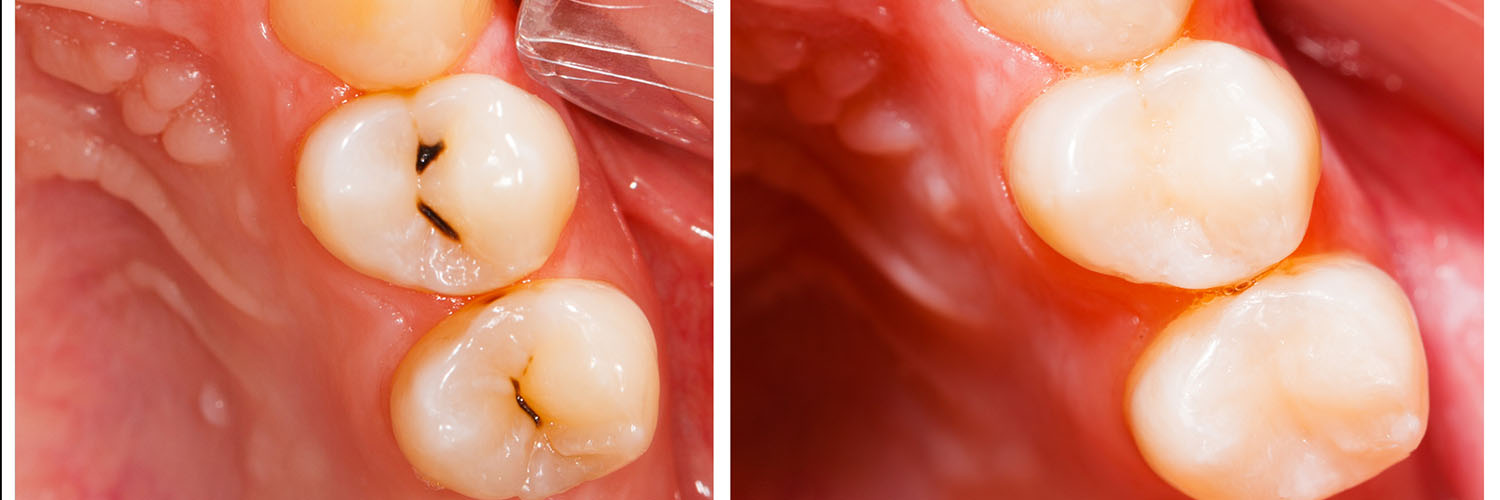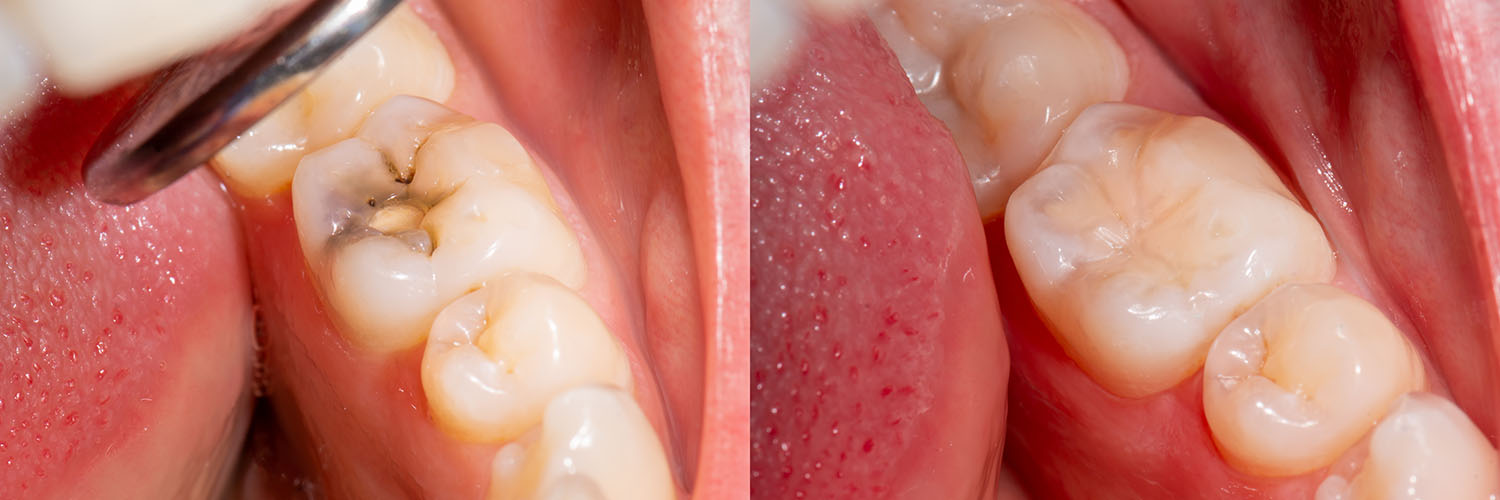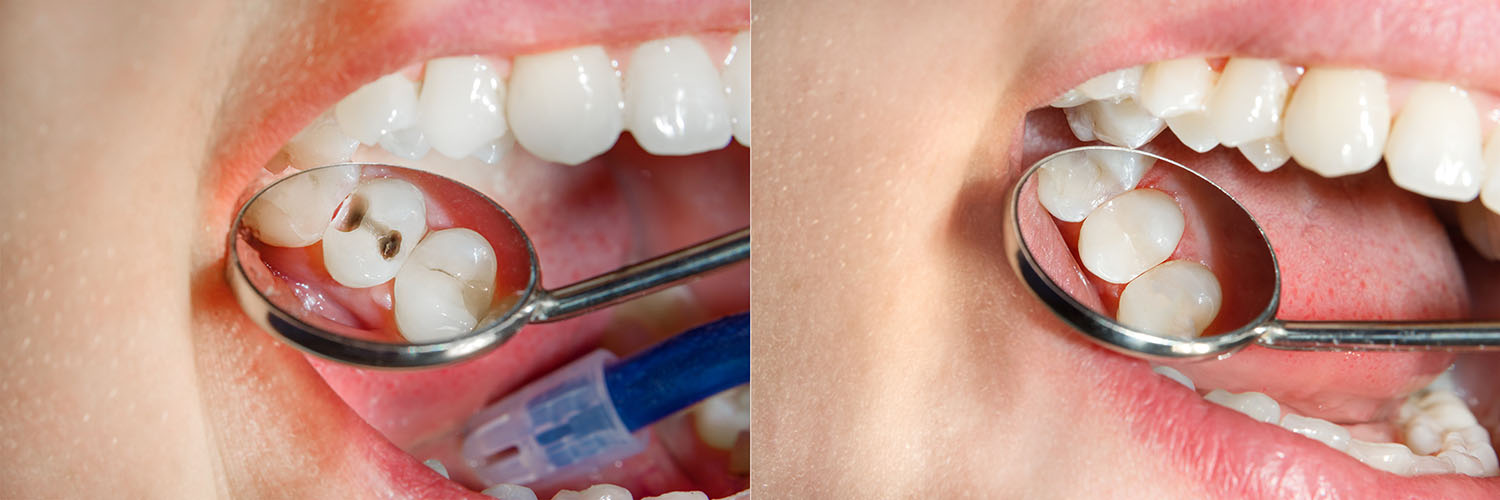Existing Patients
(515) 223-4194
New Patients
(515) 207-7409

When tooth enamel is breached by decay or minor injury, a filling is the most direct way to restore form and function. Fillings stop the spread of decay, re-establish the chewing surface, and help prevent more extensive treatment later on. For many patients a single filling returns a tooth to normal use and maintains long-term oral health.
Modern restorative techniques aim to conserve as much healthy tooth structure as possible while creating a reliable seal against bacteria. That conservative approach not only preserves strength but also reduces the chance of future sensitivity and need for more invasive procedures. A properly placed filling restores comfort, protects the tooth, and supports the surrounding bite.
At the dental office of Dr. Robert McNurlen and Dr. Austin Steil, our team focuses on precise, minimally invasive care that balances durability with natural appearance. Whether we’re treating a small cavity or repairing a chipped edge, the goal is the same: return the tooth to a healthy, functional state that blends with your smile.
Efforts to repair damaged teeth date back thousands of years, but the materials and methods used today are far more refined than early attempts. Over time, dentistry has evolved from basic metal restorations to a wide array of biocompatible, tooth-colored options. Each advance has aimed to improve longevity, safety, and how natural restorations appear.
The past several decades have seen the most rapid innovation: tooth-colored resins, glass ionomer cements, ceramic inlays, and improved adhesive techniques now allow restorations that are both strong and visually discreet. These advances give clinicians more tools to match treatment to each patient’s needs and aesthetic goals.

Not every filling material is ideal for every location or patient. Selection depends on factors such as the size and position of the cavity, the amount of remaining tooth structure, functional demands, and aesthetic priorities. A careful evaluation helps determine the best long-term option for each tooth.
Tooth-colored materials are popular for visible areas because they blend with enamel and require minimal alteration of the natural tooth. In high-stress chewing areas, clinicians may recommend more wear-resistant options or indirect restorations, which are crafted outside the mouth and bonded into place for extra durability.
During your appointment we’ll explain the advantages and limitations of each option and recommend a material that balances appearance, strength, and conservation of tooth structure. Our objective is to provide a restoration that performs reliably and looks like a natural part of your smile.
Composite resins are versatile, aesthetic, and bond to tooth structure, which can strengthen weakened areas. They are available in shade-matched tones and are used for both small repairs and cosmetic adjustments. Composites are placed directly into the prepared tooth and cured to a durable finish.
Because they require less removal of healthy enamel, composites are often preferred for preserving long-term tooth integrity. They can be repaired and adjusted in the office when needed.
Glass ionomers bond to dentin and release fluoride, which can help protect vulnerable areas from recurrent decay. They are commonly used in pediatric dentistry, for restorations near the gumline, or as a temporary solution while longer-term treatment is planned.
Ceramic restorations are crafted for durability and excellent color stability. Because they are fabricated outside the mouth—often using digital impressions—they offer a precise fit and superior wear resistance for larger cavities that still have enough healthy structure for conservation.
High-quality metallic restorations, including certain gold alloys, remain noteworthy for their longevity in select situations. While less commonly chosen for visible areas due to their appearance, metal restorations can be a strong, tissue-friendly solution where durability is the primary concern.

Treating a cavity begins with a careful exam and diagnosis. We assess the extent of decay, evaluate adjacent teeth, and consider your bite and cosmetic needs. This assessment helps us recommend an approach that addresses the issue fully while avoiding unnecessary compromise of healthy tissue.
Most filling appointments are efficient and comfortable. Local anesthesia is commonly used to keep the area numb during preparation, so you should not feel pain while the tooth is being treated. Our team takes time to explain each step and uses techniques that help minimize sensitivity after the procedure.
The specific sequence varies by material: direct restorations such as composite or glass ionomer are placed and shaped in the same visit, while indirect restorations like ceramic inlays may require two visits—one to prepare the tooth and obtain impressions, and another to bond the fabricated piece for a precise fit.
For patients who experience dental anxiety, we offer options to help you remain comfortable and relaxed during treatment. We’ll discuss the most appropriate approach for your needs and make sure you feel informed and supported throughout the process.
A new filling behaves like part of the tooth, but it also needs sensible care to last. Good daily hygiene—brushing twice a day with fluoride toothpaste and flossing—reduces the risk of new decay at the edges of the restoration. Regular professional cleanings and exams allow us to monitor the filling and catch early signs of wear or marginal breakdown.
Immediately after treatment you may notice temporary numbness from anesthesia and brief sensitivity to hot or cold. These are common and usually resolve in days to weeks. If you feel persistent discomfort, a high spot on the bite, or other unusual symptoms, contact our office so we can assess and make any necessary adjustments.
With routine care, many restorations provide years of reliable service. When a filling shows signs of failure—such as recurrent decay, fracture, or continued sensitivity—our team will recommend the appropriate next step to preserve the tooth and your overall oral health.

Choosing the right restoration is a collaboration: we’ll present clinical findings, explain the pros and cons of available options, and listen to your priorities—whether those are appearance, longevity, or preserving natural tooth structure. Our recommendations are rooted in current best practices and tailored to each individual patient.
We use contemporary materials and techniques to provide restorations that are both functional and pleasing to the eye. By combining thorough diagnosis, precise placement, and appropriate maintenance, our team helps patients protect their teeth and maintain comfortable, attractive smiles for years to come.
If you would like to learn more about how fillings could help preserve or enhance your smile, please contact Smiles for Life for more information. Our team is happy to answer questions and outline options that meet your needs.
If the pleasure of eating a delicious bowl of ice cream or sipping a soothing cup of tea gets overshadowed by dental pain that makes you wince; it's time to contact our office. As skilled providers of care, we'll determine what's causing your discomfort and perform the treatment required to alleviate your symptoms and get you back on the road to oral health.
Cavities develop because of an infectious process that causes progressive damage to tooth structure. Despite starting as a pinpoint defect on the outermost enamel layer of your tooth, untreated dental decay progressively compromises more and more healthy tooth structure as it works its way to the inner layers of your tooth.
Yes, you can still develop tooth decay on other surfaces of the tooth, around the margins of an old filling, or in fewer instances, recurrent decay underneath it. For this reason, it's essential to maintain excellent oral hygiene, a diet low in sugary beverages and sweets, and be sure to visit our office for routine checkups and care. While tooth decay is second only to the common cold in frequency, it's almost entirely preventable.
We value the time and comfort of our patients. If cavities are located on adjacent teeth, or in the same section of your smile, it may be possible to treat more than one tooth during your visit. However, how much is done each visit depends on several factors. We keep our patients well informed and tailor every treatment plan and visit to address their unique needs.
Addressing concerns on the presence of elemental mercury in silver fillings, the American Dental Association (ADA), The Center for Disease Control and Prevention (CDC), the FDA, and the World Health Organization have all stated that amalgam restorations do not pose a risk to health. However, individuals with allergies or sensitivities to the metals in dental amalgam are advised to pursue other restorative options.
Dental fillings are performed under local anesthesia to help ensure your comfort throughout the entire procedure. The involved tooth remains completely numb for the extent of your visit. Within one or two hours after the procedure is completed, the local anesthetic will gradually wear off, and normal sensations return.
A tooth-colored composite filling is fully hardened and set by the end of your visit. However, we may advise you to wait a couple of hours until the local anesthesia has completely worn off. This advice is to help ensure you don't accidentally bite your lip, cheek, or tongue while still numb.
The lifetime of a dental filling varies depending on the type of material used. While popular dental materials can last a decade or more with proper care, they can degrade over time, wear down, or even break. When this happens, you may experience some tooth sensitivity, a jagged edge, or a loose or dislodged piece of filling material. Whatever the case may be, it's essential to get the filling replaced before the tooth sustains further damage or other consequences arise. Beyond taking good care of your smile to help ensure the longevity of your fillings, our office regularly checks the status of your existing fillings as part of a routine checkup exam.
Dental fillings are an essential investment that serves to preserve and protect the health of your smile. With that said, how much a filling costs depends on the number of surfaces of the tooth involved and the filling material that is used. Amalgam restorations are the most economical. While tooth-colored composite fillings have a slightly higher cost, they offer the added benefits of being metal-free and much more aesthetically pleasing. Ceramic fillings, inlays, and onlays are more expensive than the preceding options but provide outstanding, long-lasting, and natural-looking results.
Dental insurances typically cover the cost of dental fillings. While we work with you to maximize your insurance benefits, there may still be an out-of-pocket expense. At the office of Smiles for Life, we strive to help you begin care without any additional financial stress or delay.
Dental fillings are restorative materials used to repair teeth that have been damaged by decay or minor trauma. They restore the tooth's shape, re-establish proper chewing function, and seal the area to prevent further bacterial invasion. A timely filling can often stop decay from progressing and reduce the need for more extensive treatment.
Modern techniques emphasize conserving healthy tooth structure while creating a durable seal against bacteria. This conservative approach helps maintain tooth strength and reduces the risk of sensitivity or future complications. Your dentist will evaluate the extent of damage and recommend a filling when it best preserves long-term oral health.
Common filling materials include composite resin, glass ionomer, ceramic inlays/onlays, and certain metal alloys. Composite resins are tooth-colored and bond to the enamel and dentin, offering an aesthetic and conservative option for many restorations. Glass ionomer releases fluoride and bonds chemically to tooth structure, making it useful for certain situations like restorations near the gumline or for pediatric patients.
Ceramic inlays and onlays are indirect restorations fabricated outside the mouth for a precise fit and superior wear resistance in larger defects. Metal alloys, including select gold formulations, remain notable for durability in high-stress areas where appearance is less critical. Each material has trade-offs between longevity, strength, aesthetics, and tooth preservation, which your dentist will review with you.
Material selection depends on factors such as the size and location of the cavity, the amount of remaining tooth structure, bite forces, and aesthetic priorities. For front teeth or visible areas, tooth-colored composites are often preferred because they blend with enamel and require minimal alteration. For back teeth subjected to heavy chewing, the dentist may recommend a wear-resistant material or an indirect restoration like a ceramic inlay for added durability.
Other considerations include the patient’s oral hygiene, history of recurrent decay, and any sensitivity or allergy concerns. The dentist will explain the advantages and limitations of each option and recommend a solution that balances appearance, function, and preservation of natural tooth structure. Shared decision-making ensures the chosen material aligns with clinical needs and patient preferences.
A filling appointment typically begins with a thorough exam and diagnosis, including visual inspection and radiographs if needed to assess the extent of decay. Local anesthesia is commonly used to numb the area so you do not feel pain during the procedure, and the dentist will remove decayed tissue and shape the cavity to receive the restoration. For direct restorations like composite or glass ionomer, the material is placed, shaped, and cured in a single visit.
When an indirect restoration such as a ceramic inlay is recommended, you may need two visits: one to prepare the tooth and take impressions or digital scans, and another to bond the fabricated piece into place. Throughout the procedure the team will explain each step and take measures to keep you comfortable. If dental anxiety is a concern, your dentist can discuss options to help you remain relaxed during treatment.
Most patients experience little to no pain during a filling because the area is numbed with local anesthesia before work begins. You may feel pressure or vibration while the dentist removes decay and shapes the tooth, but the anesthetic prevents sharp pain. After the procedure, it is common to have temporary numbness until the anesthesia wears off.
Some sensitivity to hot, cold, or biting can occur for a few days to weeks as the tooth settles, especially if the decay was deep or close to the nerve. The dental team will recommend gentle care and may provide guidance for managing sensitivity if it persists. Contact the office if you experience prolonged or severe discomfort so the restoration and bite can be evaluated and adjusted if necessary.
The lifespan of a filling depends on the material used, the size and location of the restoration, and how well the patient maintains oral health. Composite fillings and glass ionomer restorations can last many years with proper care, while ceramic and high-quality metal restorations are often more durable in high-stress situations. Bite forces, grinding, and recurring decay at the margins can shorten a filling’s functional life.
Regular dental exams and professional cleanings allow your dentist to monitor restorations and detect early signs of wear or marginal breakdown. Maintaining good oral hygiene, wearing a protective nightguard if you grind your teeth, and addressing small issues promptly help extend the service life of fillings. When a filling shows signs of failure, the dentist will recommend an appropriate next step to preserve the tooth.
Yes, old fillings can and should be replaced when they show signs of failure such as recurrent decay, fracture, marginal leakage, or persistent sensitivity. X-rays and clinical examination help determine whether a restoration should be repaired or entirely replaced. Timely replacement prevents further breakdown of tooth structure and reduces the likelihood of needing more invasive procedures.
Replacing a worn or compromised filling offers an opportunity to select a material better suited to the current condition of the tooth. Your dentist will explain the recommended approach and the expected sequence of treatment. In many cases a conservative replacement restores function and comfort while preserving as much natural tooth as possible.
Tooth-colored composite fillings have improved significantly and can provide excellent strength for many applications, particularly when they bond directly to the tooth and help reinforce weakened areas. However, certain metal alloys and indirect ceramic restorations may offer superior wear resistance in very large or high-stress restorations. The appropriate choice depends on the tooth’s functional demands and the amount of remaining healthy structure.
Dentists often balance aesthetic goals with mechanical requirements by choosing materials or combining approaches to achieve both durability and natural appearance. For larger defects, an onlay or crown may be recommended to provide long-term protection rather than a direct filling alone. Your dentist will discuss material performance and select the option that best fits your clinical needs.
Immediately after treatment you may have numbness from anesthesia, so avoid chewing until sensation returns to prevent accidental biting of the cheek or tongue. Maintain gentle oral hygiene by brushing twice daily with fluoride toothpaste and flossing carefully around the restored tooth to reduce the risk of new decay at the margins. Follow any specific instructions provided by the dental team, such as avoiding very hard or sticky foods for a short period.
If you notice a high bite, persistent sensitivity, or any sharp edges after the anesthetic wears off, contact the office so the restoration can be adjusted. Routine dental visits and professional cleanings allow the clinician to monitor the filling’s condition and address minor issues before they progress. With sensible care, many restorations continue to function reliably for years.
Preventing cavities is the most effective way to reduce the need for fillings, and that starts with consistent oral hygiene habits: brushing twice daily with fluoride toothpaste, daily flossing, and limiting frequent exposure to sugary or acidic foods and beverages. Regular dental checkups and professional cleanings help detect early signs of decay when minimally invasive treatment is most effective. Your dentist may recommend fluoride treatments or dental sealants for additional protection in appropriate cases.
Lifestyle factors such as tobacco use and dry mouth can increase decay risk, so discussing these with your dental team allows for targeted preventive strategies. Personalized advice from the dental office of Dr. Robert McNurlen and Dr. Austin Steil can help you build a prevention plan tailored to your oral health needs. Early intervention and routine care are key to preserving natural tooth structure and avoiding more extensive restorations.